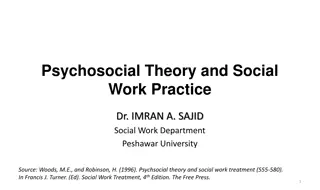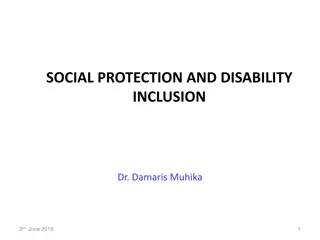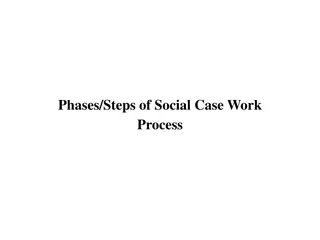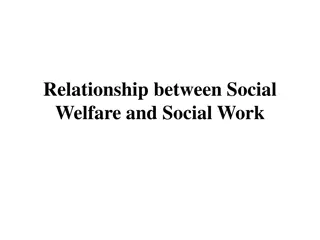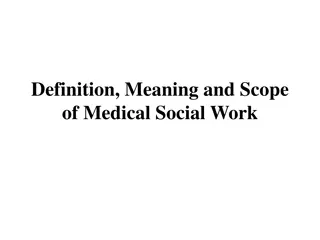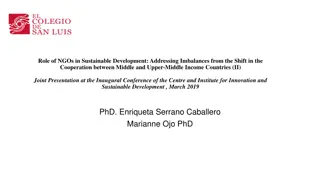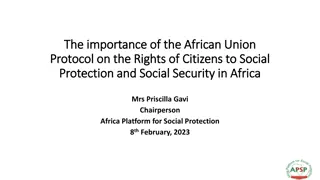Imbalances in Social Protection for New Forms of Work
The European Commission, through public hearings and initiatives like the European Pillar of Social Rights, is addressing imbalances in social protection for atypical workers. The focus is on ensuring access to social protection for workers, including those in non-standard forms of employment such as temporary, part-time, and self-employed positions. With a significant portion of the EU workforce engaged in atypical work, there is a need to adapt social protection policies to meet the evolving labor market dynamics. The implementation of recommendations and mutual learning events aims to enhance social rights and support a strong Social Europe.
Download Presentation

Please find below an Image/Link to download the presentation.
The content on the website is provided AS IS for your information and personal use only. It may not be sold, licensed, or shared on other websites without obtaining consent from the author.If you encounter any issues during the download, it is possible that the publisher has removed the file from their server.
You are allowed to download the files provided on this website for personal or commercial use, subject to the condition that they are used lawfully. All files are the property of their respective owners.
The content on the website is provided AS IS for your information and personal use only. It may not be sold, licensed, or shared on other websites without obtaining consent from the author.
E N D
Presentation Transcript
EESC - public hearing on Imbalances in social protection in general and specifically for the "new forms of work" and "atypical workers" Dana-Carmen Bachmann European Commission (DG EMPL) Head of Unit - Social Protection Unit
European Pillar of Social rights EPSR endorsed in 2017, with 20 key principles, towards a strong Social Europe guiding EU level incl. Action plan adopted in March 2021 + Porto Social Summit and Declaration to complement national A number of EU proposals over 2020-23 to advance social rights
Access to social protection for workers and the self-employed in the EU
Context: some figures In 2023, almost 40% of the population in employment in the EU-27 (78 million people) were in non-standard forms of work i.e. with a temporary contract (23.6 million), part-time work (38.1 million) and/or self-employed: 28 million including 19.9 million solo self-employed (among which around 750,000 dependent self-employed ) Proportion of people in non-standard forms of work has been stable over the last decade; and situation vary greatly between and within groups ..but some new forms of employment (casual workers, portfolio workers, platform workers) have become more prevalent 28 million people in the EU work through digital labour platforms
Labour market statuses by Member State (aged 15-74), 2023 (%) Labour market statuses in EU27, 2023 (%) Full-time permanent employee 100% 1% Labour market statuses in EU27, 2023 (%) 4% 9% Full-time temporary employee Part-time permanent employee 90% 4% 80% 70% 13% 60% 62% 50% 8% 40% 30% 20% 10% 0% LU Full-time temporary employee Part-time temporary employee Self-employed without employees LT LV MT RO NL IT CZ DE BE ES DK SE IE CY HR EE SK HU BG AT Full-time permanent employee Part-time permanent employee Self-employed with employees Family worker EU27 PT EL FR FI PL SI Source: EU-LFS (2023), DG EMPL calculations
Implementation of the Recommendation New mutual learning events; further implementation; and development of the monitoring framework Analysis of the plans, consultations of stakeholders and policy exchanges Adoption by the Council of the EU Establishment of a monitoring framework (MF) May-Sept 2021 November 2019 Early 2023 November 2020 2021-22 2019- 2020 2023-2024 Mutual learning workshops Plans informing about national measures Report by the European Commission Update improvements of the MF and
Main conclusions of the report Mixed picture regarding implementation efforts; overall level of ambition varies significantly across Member States With a few exceptions, most Member States do not aim to address all existing gaps in access to social protection Large number of workers or self-employed people are still left without sufficient access to social protection Starting point is very diverse logical to see fewer commitments to new structural reforms in Member states with already universal/generous systems but not in a number of Member states where non- standard workers and self- employed are still not (adequately) covered Some ambitious reforms (focused on formal coverage) in half of the Member States
Useful links Council recommendation (2019) on access to social protection for workers and the self-employed: National plans Factsheet report Report in all EU languages access to social protection future of social protection adequate minimum income update Monitoring framework on access to social protection - and update National plans Commission s Report (2023) on its implementation ESPN report on transparency (2023) in 35 European countries Council Recommendation of 30 January 2023 on adequate minimum income ensuring active inclusion Report of the High-Level group on the future of social protection and of the welfare state in the EU Factsheet Summary and recommendations in all EU languages
Thank you for your attention Dana-Carmen.BACHMANN@ec.europa.eu DG EMPL Head of Unit, Social Protection European Commission
Formal coverage: some ambitious reforms Structural reforms in 15 Member states : already adopted in 5 - while planned in 10 For self-employed: plans to providing/improving access to unemployment in EE, LT, BE (bridging rights); social insurance coverage in CY, disability insurance in the NL, sickness benefits in EL, paternity benefits in RO For non-standard workers: access to unemployment benefits for domestic workers in ES improvement in coverage for workers from cultural sectors in PT PL to extend mandatory insurance and improve coverage of civil law contracts; protection by sickness benefits to employees without a scheme in IE; RO planning to ensure formal access to all social security branches for seasonal and day workers as well as platform workers
Effective coverage: some policy measures Gaps in effective access recognised as a challenge in the national plans but few structural reforms Majority of measures reported were taken on a temporary basis in response to the COVID 19 pandemic (for instance eligibility conditions loosened for UBs, sickness or income support for self-employed) Some reforms improving effective coverage: ES (unemployment assistance) IT (improved access for non-standard workers) LT (preparing reform of unemployment insurance) Little focus in the plans on how to improve transferability of entitlements
Adequacy: focus on some branches Adequacy is addressed in 16 national plans Many focussed on improving pensions for the self-employed (BE, ES, FI, LV, PT) or employees with low entitlements (AT, CZ, DE, EE, FR) Mostly temporary measures to improve the adequacy of unemployment benefits (e.g. duration prolonged or degressivity suspended) some structural Only few measures to improve adequacy of other branches (sickness, invalidity, healthcare) reported in the plans Relatively few measures to improve adequacy of social protection for workers in non- standard jobs (some focused on cultural sector workers)
Transparency Not much addressed in national plans ..even if there are reforms across the EU to support access to clear and up-to-date information and awareness of social rights, and to simplify procedures ..in many cases through the Recovery and Resilience Plans Some MSs state that the rules on access to social protection are already clear and transparent and that information is accessible (e.g. BE, EE, FR, HR, MT, SE), with some also highlighting the importance of maintaining/improving this (BE, LU, MT, NL, SE) Complex dimension to monitor / compare Analysis based on 2022 ESPN report on transparency (and 35 national reports) ESPN report on transparency
Transparency / Access to information General and personalised information: trends towards digitalisation (online portals, personal accounts, online tools, information per specific status) Awareness raising campaigns in 14 EU Member States since 2017 (e.g. in case of reform; to inform about future entitlements, benefits of joining a scheme, COVID-19 measures, etc) Gaps: Some information gaps and shortcomings specifically affecting (sub-groups of) non-standard workers and the self-employed (for instance information on voluntary schemes) Online calculators exist but almost only for pensions Limited knowledge of sickness, healthcare and old-age benefits Complex language, outdated information Access to information for vulnerable groups (people with visual/hearing impairments, older people or homeless people) ; digital divide; physical venues still matter
Transparency / Simplification Simplification can be done in: or in the application/receipt process for accessing benefits formal rules of a social protection scheme; administration (institution) structure; Several MSs are simplifying access to general or specific schemes (AT and PT: simpler rules for self-employed); merging benefits into unified schemes or harmonisation of regulation; simplification of contribution payment systems, one stop social security portals; once-only principle for data collection, partial automation of data exchange Application procedures: web portals with integrated functionalities for users and sharing of data among the different institutions; online and pre-filled application procedures (DE, IT, SK); some rare examples of automatic granting of benefits for eligible people in specific branches






